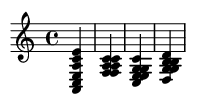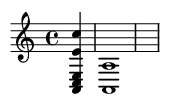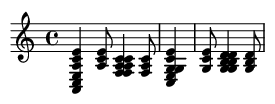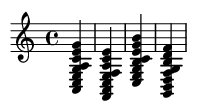The vi-IV-I-V progression, often called the "sensitive female" or "pessimistic" pop progression, is one of the most emotionally resonant chord sequences in modern music. Unlike progressions that start on the tonic (I), this one begins on the relative minor (vi), immediately creating a sense of melancholy, reflection, or yearning. This starting point sets up a compelling harmonic journey that finds hope in the IV and I chords before the V chord pulls it back to the start, creating its famously cyclical nature.
In the key of C major, the progression is built from the following chords:
- vi chord (Submediant): A minor (A-C-E) - The minor-key starting point.
- IV chord (Subdominant): F major (F-A-C) - Provides lift and movement away from the minor feel.
- I chord (Tonic): C major (C-E-G) - The major-key "home," offering temporary resolution.
- V chord (Dominant): G major (G-B-D) - Creates tension that powerfully leads back to the beginning of the cycle.
Here is the basic progression in C major, with one chord per measure:

Each chord in the vi-IV-I-V progression plays a distinct role in its narrative arc, like acts in a short story.
Act 1: vi - The Question
Starting on the relative minor immediately establishes an introspective or somber mood. It feels unstable, like a question or a problem being presented. This is the emotional heart of the progression.
Act 2: IV - The Lift
Moving to the major subdominant (IV) introduces a sense of hope or forward motion. It's a lift away from the melancholy of the vi chord, suggesting a potential solution or a change in perspective.
Act 3: I - The Fleeting Answer
The arrival at the tonic (I) chord feels like a moment of clarity or homecoming. It provides temporary stability and relief, answering the question posed by the vi chord. However, it doesn't last.
Act 4: V - The Anticipation
The dominant (V) chord's primary function is to create tension that pulls strongly back to the tonic (I). But in this progression, it instead pulls back to the vi chord, subverting expectations and creating a loop. This move generates anticipation and a feeling of an unresolved cycle, compelling the listener to hear it again.
This progression is ubiquitous. You've heard it in countless hit songs across genres. Note that some songs may use variations, but the core emotional feel comes from this harmonic DNA.
- "Someone Like You" by Adele: A quintessential piano ballad that uses the progression to convey heartbreak and nostalgia.
- "Don't Stop Believin'" by Journey: The iconic piano intro is a perfect example of this progression, setting a hopeful yet determined tone.
- "With or Without You" by U2: Builds an entire atmospheric anthem on the repetition of these four chords.
- "Let It Be" by The Beatles: While the verse is I-V-vi-IV, the progression is inverted, showing its close relationship and similar emotional palette. The vi-IV-I-V feel is a key part of its DNA.
- "Complicated" by Avril Lavigne: Drives the chorus with this progression, giving it pop-punk energy with underlying emotional depth.
- "Africa" by Toto: The chorus soars over a classic vi-IV-I-V, creating its epic and timeless feel.
Smooth Voice Leading
One reason for the progression's smooth, satisfying sound is its excellent voice leading. The notes in each chord can move to the next with minimal motion, often by step or by holding common tones. Notice the smooth lines in this four-part example:

Functional Harmony
The progression tells a clear story using harmonic functions:
- vi (Submediant) : Functions as a "tonic substitute" but with a minor quality, giving the home base a darker color.
- IV (Subdominant): Provides "predominant" function, moving away from the tonic area and preparing for the dominant.
- I (Tonic): The stable center of the key, providing resolution.
- V (Dominant): The strongest pull back towards the tonic. The V -> vi move that restarts the loop is a form of "deceptive cadence," which avoids the expected V -> I resolution and keeps the cycle going.
Ballad Style
Pattern: One chord per measure (whole notes or half notes). This slow pace allows each harmony to breathe and lets the emotional weight of each chord sink in. See the first example in this post.
Pop/Rock Drive
Pattern: Two beats per chord, often with a driving eighth-note strumming pattern. This creates energy and forward momentum.

Arpeggiated Approach
Pattern: Breaking the chords into individual notes (arpeggios) . This is common in piano ballads and fingerpicked guitar parts, creating a more delicate and intricate texture.

The key you choose can significantly impact the progression's feel and playability.
- C Major (Am-F-C-G) : The standard. Easy to visualize and play on piano, great for teaching.
- G Major (Em-C-G-D): Extremely guitar-friendly due to the use of open chords. Has a bright, folk-like quality.
- D Major (Bm-G-D-A): Another bright, powerful key for guitar. Very common in pop and rock.
- A Major (F#m-D-A-E): A favorite for anthemic rock. The chords ring out with power and clarity on guitar.
- F Major (Dm-Bb-F-C): Has a fuller, warmer sound, often favored in R&B and soul music.
When writing a melody over vi-IV-I-V, leverage the emotional arc of the chords:
- Anchor on Chord Tones: Start by building your melody from the notes within each chord. This ensures your melody is harmonically supported.
- Emphasize the Minor Start: Use notes from the natural minor scale (e.g., A natural minor in the key of C) over the vi chord to highlight its melancholy character.
- Build to the Climax: Save your highest or most powerful melodic notes for the I chord. This creates a satisfying peak where the harmonic and melodic resolution align.
- Use Stepwise Motion: Smooth, connected melodic lines work beautifully with the smooth voice leading of the progression.
Extended Chords
Adding 7ths, 9ths, or other extensions can introduce more complexity and emotional nuance. A common and beautiful variation is vi7 – IVmaj7 – Imaj7 – V7.

Harmonic Rhythm Variations
- Double Time: Spend twice as long on each chord (e.g., two bars of vi, two of IV, etc.) . This slows the emotional development and is great for intros or bridges.
- Anticipation: Push the last chord (V) into the final beat of the measure before it, creating a "push" or syncopation that increases drive.
- Unresolved Ending: End a section or song on the vi chord to leave the listener with a feeling of lingering sadness or incompletion.
The Perfect Verse
The vi-IV-I-V progression excels in verses because its cyclical, questioning nature builds a foundation for a more declarative chorus. It allows the lyrical story to unfold over a harmonically interesting but not distracting backdrop.
The Power Chorus
When used in a chorus, the progression becomes an unforgettable hook. Its combination of minor-key emotion and major-key lift creates a powerful, universally appealing emotional climax that listeners can connect with instantly.
- Master the Changes: Play the basic progression in several keys until the transitions are effortless. Focus on economy of motion with your fingers.
- Experiment with Rhythm: Apply different strumming, picking, and rhythmic patterns to feel how the groove changes the emotional impact.
- Learn from the Masters: Actively listen to the songs listed above. Analyze how they use the progression—where does it appear? How does the melody interact with it?
- Improvise Melodies: Record yourself playing the progression and practice improvising melodies over the top. Start with chord tones and gradually add more color.
- Transpose on the Fly: Challenge yourself to play the progression in unfamiliar keys. This solidifies your understanding of the Roman numerals, not just the chord shapes.
- Compose with It: Try writing a short verse and chorus using the progression. Experiment with using it for one section and a different progression for the other.
